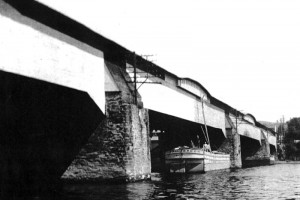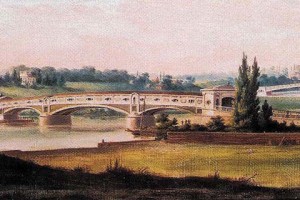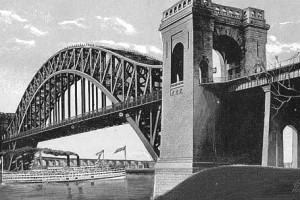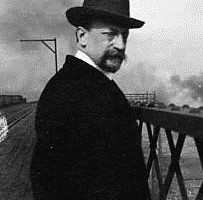The Baltimore & Ohio Railroad broke ground in Baltimore, Maryland on July 4, 1827 and planned on running from Baltimore to the Ohio River along the Potomac River to Cumberland, Maryland. After delays at Point of Rocks due to a right of way conflict with the Chesapeake and Ohio (C&O) Canal, it arrived at Sandy Point, across the river from Harpers Ferry, on December 1, 1834. …
Author Archives : Frank Griggs, Jr., Dist. M. ASCE, D. Eng., P.E., P.L.S.
About the author ⁄ Frank Griggs, Jr., Dist. M. ASCE, D. Eng., P.E., P.L.S.
Dr. Frank Griggs, Jr. specializes in the restoration of historic bridges, having restored many 19th Century cast and wrought iron bridges. He is now an Independent Consulting Engineer. (fgriggsjr@twc.com)
In 1811, the only bridge crossing the Schuylkill River near Philadelphia was Timothy Palmer’s Permanent Bridge that opened in 1805 (STRUCTURE®, October 2013). Ferries continued to serve the community at the Upper Ferry (Sheridan’s) and the Lower Ferry (Gray’s). Both of these ferries at times also had floating bridges adjacent to them. As early as January 30, 1811, an Act was submitted to the legislature authorizing “A company for erecting a permanent bridge over the River Schuylkill at or near where the floating bridge of Abraham Sheridan is at present situate, known by the name of the upper ferry in the County of Philadelphia.” …
Theodore Burr had just finished his Union Bridge in Waterford, NY (STRUCTURE, February 2014) when he was called to Trenton, New Jersey to build a toll bridge across the Delaware River just above the falls. …
The Union Bridge, connecting Waterford and Lansingburgh, New York, was the first to cross the Hudson River in its 154 mile course from New York harbor northward. It was located near a long time ford and ferry crossing. The first act leading to the bridge was passed by the legislature on April 15, 1800 when it authorized building of toll bridges across the Hudson River. Nothing was done until late 1802 or early 1803, when a group of the leading men of Waterford and Lansingburgh proposed the formation of the Union Bridge Company to build a toll bridge at the site. …
America’s First Covered Bridge
A crossing of the Schuylkill River on the extension of Market (Formerly High) Street in Philadelphia had been a pressing need for many years when, in 1723, an act was passed entitled “An Act for establishing a ferry over the river Schuylkill, at the end of the High Street of Philadelphia.” In 1767, a bridge over the river at the Middle Ferry was first proposed. …
The Piscataqua Bridge across the Great Bay of the Piscataqua River is located six miles west of Portsmouth, New Hampshire, and was built in 1794 with a span of 244 feet. It was the longest span bridge in the United States when it opened, holding that record until Lewis Wernwag built his Colossus Bridge across the Schuylkill River north of Philadelphia in 1812 with a span of 340 feet. Timothy Palmer had built bridges across the Merrimack River in Massachusetts, and was a pioneer in long span wooden truss bridge design and construction when he was called to build the most difficult part of the Piscataqua Bridge. …
This is the first in a series of articles on the historic bridges of the United States. It will include those bridges the writer believes were the most significant structures since 1793 built in wood, iron and steel. Up to then, most bridges built in the country were wooden pile and stringer bridges built in much the same manner as Caesar did when crossing the Rhine centuries before. …
Ammann was born on March 26, 1879, in Schaffhausen, Switzerland, the home of the famous 18th century Grubenman wooden bridge. His family was of moderate means with his father in manufacturing and his mother in hat making. At an early age he showed an aptitude for mathematics and began studying for a civil engineering degree at the Polytechnikum in Zürich, Switzerland. He graduated in 1902. …
Modjeski, (ne. Rudolphe Modrzejewska) was born in Cracow, Poland on January 27, 1861. His mother was an internationally known actress who encouraged him to become a concert pianist. But, at an early age, he determined he would become a civil engineer. His family came to the United States to attend the Centennial Celebration in Philadelphia and start an orange farm near Anaheim, California. His mother continued her acting career and Modjeski attended schools in the San Francisco area for a short time. In 1878, Ralph went to France to prepare for study at the École des Ponts et Chaussés, one of the leading schools of Civil Engineering in Europe. After failing admission on his first attempt, he was accepted and graduated in 1885 at the top of his class. Shortly after, he returned to the United States. …









